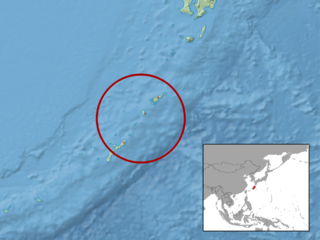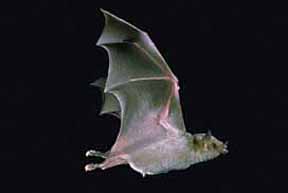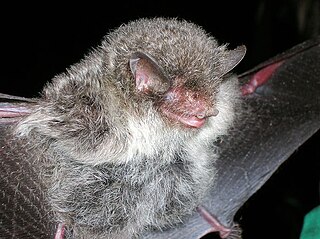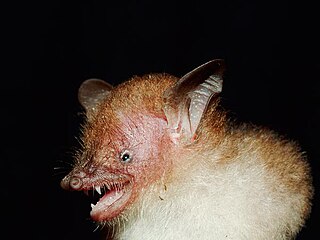
Marinkelle's sword-nosed bat is a bat species found in Colombia. In 2013, Bat Conservation International listed this species as one of the 35 species of its worldwide priority list of conservation. Its species name marinkellei was chosen to honor the Dutch scientist Cornelis Johannes Marinkelle, who worked in Colombia.

Murina is a genus of vesper bats. They are found throughout temperate and tropical regions of Asia.
The Guadeloupe big brown bat is a species of vesper bat. It is found only on the island of Guadeloupe. It is one of the eleven species of bat found on Guadeloupe, and one of three that are endemic.

The flute-nosed bat is a vespertilionid bat with an unusually shaped nose, the tubular nostrils facing outward from the end of the muzzle. They occur in the north of the Australian state of Queensland, in Indonesia, and on Papua New Guinea.
Scully's tube-Nosed bat is a species of vesper bat in the family Vespertilionidae. It can be found in the following countries: India, Laos, Myanmar, Pakistan, Thailand, and Viet Nam.

The Ussuri tube-nosed bat is a species of vesper bat in the family Vespertilionidae. It is threatened by habitat loss. It is the only species of bat that hibernates in snowbanks.

Findley's myotis is a species of vesper bat. It is found only on the Tres Marías Islands off the west coast of Mexico.

The Yanbaru whiskered bat(Myotis yanbarensis) is a species of vesper bat in the genus Myotis.

The Aba roundleaf bat, also known as the Aba leaf-nosed bat is a species of bat in the family Hipposideridae. It is found in West Africa along the southern coast from Nigeria to Senegal. Populations have also been noted in Sudan and Uganda. Its natural habitats are subtropical or tropical moist lowland forests, dry and moist savannas, and caves.

The Kolar leaf-nosed bat, or leafletted leaf-nosed bat is a species of bat in the family Hipposideridae. It is endemic to India. Its natural habitats are subtropical or tropical dry forests and caves. It is found in only one cave in India, and its population is less than 200 individuals.

Jones's roundleaf bat is a species of bat in the family Hipposideridae. It is endemic to southern West Africa. Its natural habitats are subtropical or tropical dry forest, savanna, subtropical or tropical dry lowland grassland, rocky areas, and caves and other subterranean habitats.

The greater long-nosed bat or Mexican long-nosed bat is a species of bat in the family Phyllostomidae. It is found in Mexico and the United States. It chiefly consumes pollen and nectar, particularly from agave plants and cacti. Its habitat includes desert scrub and open woodlands. It is threatened by habitat loss.

The demonic tube-nosed fruit bat is a species of bat in the family Pteropodidae. It is endemic to Papua New Guinea. The holotype specimen was collected in 1979 on New Ireland, in the Bismarck Archipelago. It was described as a new species in 1983. The range of the species may extend to other islands, however the extent of the range is not presently known.

The lesser yellow-shouldered bat is a species of bat in the family Phyllostomidae. It is native to Peru and Ecuador. It is threatened by habitat loss.

Hilgendorf's tube-nosed bat is a species of vesper bat in the family Vespertilionidae. In Japan they are called 'tengu komori', after the mythical creature called the Tengu. It was formerly thought to be a subspecies of Murina leucogaster, but is now known to be a distinct species.

Beelzebub's tube-nosed bat, also Beelzebub bat or demon bat, is a species in the vesper bat family Vespertilionidae, found in the Greater Mekong region of Southeast Asia, specifically the Quảng Trị and Gia Lai provinces of Vietnam. They have tube-shaped nostrils which assist them with their feeding.

Fea's tube-nosed bat, also known as the ashy tube-nosed bat, is a species in the vesper bat in the family Vespertilionidae, found in southeastern Asia and southern China. They have tube-shaped nostrils which assist them with their feeding. It is named after Italian naturalist Leonardo Fea.

Walston's tube-nosed bat is a species in the vesper bat family Vespertilionidae, found in the Greater Mekong region of Southeast Asia, specifically the Đắk Lắk Province of Vietnam and the Koh Kong and Ratanakiri provinces of Cambodia. This species was discovered in northeastern Cambodia in the Van Sai Protected Forest. They have tube-shaped nostrils which assist them with their feeding.

Thongaree's disc-nosed bat is a critically endangered species of bat found in Thailand. It is the only member of the genus Eudiscoderma.
The Formosan golden tube-nosed bat is native to the high-altitude regions of Taiwan.

















